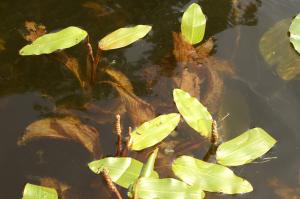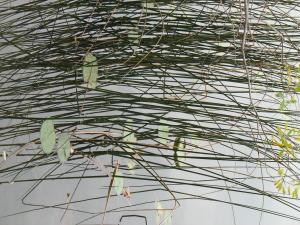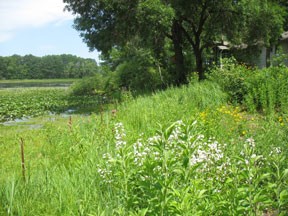What's Working for Conservation
Containerized and Bare-Root Plant Use
2018 Information
Planting and Establishment of Submergent Vegetation: "Getting aquatic plants to grow in deeper water is a challenge. We used to weight the tubers with nails and staples, but due to environmental concerns, we have discontinued this way of weighting the tubers. We now send along cheese cloths bags for customers to put 5 tubers in each bag, along with some mud or stones that are heavy enough to keep the bag in the bottom. The trick is to try to make the bag as stationary as possible in the bottom, so the tubers can get rooted. There is usually enough extra bag to push into the soil, to help it from floating around the bottom. We usually suggest planting in 18 to 24 inches of water to get the aquatics started, and they will then grow out into the deeper water as they can tolerate.”
(Kester’s W.G.F. Nurseries)
Lakeshore Planting: In a research project studying factors affecting the establishment of soft-stemmed bulrush in urban lakeshore restorations, D.A. Vanderbosch and S.M. Galatowitsch found the following:
- Water depth to only be important immediately after planting, after which time, its influence on successful establishment diminishes.
- Limits to aquatic growth include water depth, development of belowground biomass prior to winter dormancy, and seasonal growth habits.
- Few transplants survived autumn transplanting (0.7%) compared to high survival in spring (61.2%) Spring rhizome survival was greater than fall survival (in Spartina alternaflora).
- Planting aquatic emergent in early to mid-summer likely results in higher survivorship than planting in late summer or fall.
- Research to elucidate which aquatic plating practices will most reliably result in the survival of littoral revegetation in needed.
- The restoration goal for the littoral zone is to replace emergent vegetation that has been completely removed.
- Shallow water zone was defined as the area between 0 and 30 cm of water depth; the deep water zone between 31 and 60 cm of water depth.
- Pots planted in June yielded the highest overall mean post-winter survival (39%). Mean post-winter survival for pots planted in August (3%) and formats plated in Sept (3%). Survival of June pots was 16% greater than of mats planted the same month.
- The establishment of aquatic plantings was primarily affected by the time of restoration and type of transplant; water depth was less important.
- Greatest survival from bulrush and Carex planted early in the growing season (June).
- Bulrush survival in the shallow water zone was lower than the deep water zone the month following planting, but the influence of water depth diminished over time.
- C. lacustiris and C. stricta seedling survival was highest when the soil surface was moist to saturated, and declined under conditions of extended flooding. In contrast, higher mortality in shallow water was observed in this study.
- Potential limiting impacts: shading from riparian trees and shrubs and burial by sand/sediment and racked vegetation.
- Littoral vegetation success can be improved by avoiding late season plantings and using transplants propagated in mats.
- The increasingly common practices of late season plantings using mats results in survival rates of 5% or less.
- Water level regulation and stormwater inputs that create hydrologic regimes that alter species composition and reduce structural diversity of aquatic macrophyte communities. (Vanderbosch, Galatowitsch; 2009)
Plug Establishment: With scarce seed supplies for some of the less common native species, the production of plants can be maximized by starting plants in trays. When starting plants from seed or cutting, the regular 36 to72 cell trays work well, especially when the clear covers are used. The plugs develop alright for fibrous rooted plants although the plugs aren’t deep enough for good survival when planting into dryer soils. But with plants that develop tap roots, their roots will zig-zag and ball up as they try to go down beyond the bottom of the cell (Martin SWCD).
Plug Establishment: The University of Northern Iowa, working on the “Iowa Ecotype Project” has been using trays with cone shaped inserts. The 1.5” diameter inserts are 8.25 inches deep and 98 fit in a 1 foot by 2 foot tray. 1” diameter inserts, with a 6.34 inch depth fit a 1 foot by 2 foot tray that holds 200 inserts. This system allows for straighter tap root formation and when transplanted, allows roots to reach deeper, into better moisture conditions than conventional plugs. A dibble bar can be made or purchased that conveniently pokes a cone shaped hole to drop the plugs into. Then all that is needed is to crimp the soil in around the top of the plug (Martin SWCD).
Tree Mats: Tree mats have been useful to suppress weeds when planting bare root conifers, avoid monocultures, select specifications suitable to the site and native plantings hardy to the area (Redwood SWCD).
Fitting Plants to Moisture Levels: It is important to select the right plant for the right location, in particular, selecting plants for the right moisture levels (pictured right). It is beneficial to group species that are found in the same plant community (Shawn Tracy, Association of Metropolitan Soil and Water Conservation Districts).
Planting time: Planting as early in the season as possible to utilize early season moisture is beneficial, particularly for bare-root trees and shrubs and transplants (Dan Shaw, BWSR)
Rooting in Containers: Using plants that are healthy and fully rooted in containers helps ensure that they will be able to better adapt to planting conditions (Dan Shaw, BWSR)
Bound Roots: Breaking up compacted root systems with a garden weeder can be an important practices to ensure that roots grow outward rather than staying in a tight mass. Pruning or redirecting roots of woody plants that are growing in a circular directions is particularly important to ensure that they don’t girdle the stem and that lateral roots develop to stabilize trees and keep them from blowing over (Dan Shaw, BWSR).
Bare-root plants: It is essential to keep bare root plants wet/moist until planting or they may not survive (Dan Shaw, BWSR).
Weed Suppression: Using craft paper or similar products under wood mulch can be effective to suppress weeds around containerized plants (Dan Shaw, BWSR).
Weed Suppression: Applying approximately 10 layers of newspaper before spreading double shredded hardwood mulch to inhibit weeds. Mulch is pulled aside for planting and a planting hole cut into the newspaper (Rusty Schmidt, Washington Conservation District).
Planting Holes: Digging planting holes large enough to accommodate the entire root system of bare-root plants is important to allow roots to grow outward as well as downward (Dan Shaw, BWSR).
Holes for Trees and Shrubs: Digging holes 2.5 the width of a container when planting containerized trees and shrubs helps ensure that roots can grow laterally and provide support for the plant (Dan Shaw, BWSR).
Planting Depth: It is important to ensuring that root flairs (the highest point of the root) are not deeper than 1-inch below the ground surface when planting trees, otherwise the roots will not be able to receive sufficient oxygen and planting too deep also leads to root girdling where the roots grow in a circular pattern and can constrict the main stem (Dan Shaw, BWSR).
Water Holding Gels: Using water holding gels as part of planting can be a useful practice when plants will not be watered afterward or watered infrequently (Dan Shaw, BWSR).
Protection from Grazers: Using methods to exclude deer and rabbits from damaging newly planted trees and shrubs by using tree tubes, wire mesh, fencing and bud caps can be very important part of projects in areas where wildlife damage is likely. In some cases solar powered electric fences can be effective for deer but can take some maintenance as they don’t work if vegetation touches the wires (Dan Shaw, BWSR).
Plants for Stormwater Design is a publication that was designed to aid plant selection for a wide range of stormwater project types, it can be found at: http://www.pca.state.mn.us/index.php/water/water-types-and-programs/stormwater/stormwater-management/plants-for-stormwater-design.html



